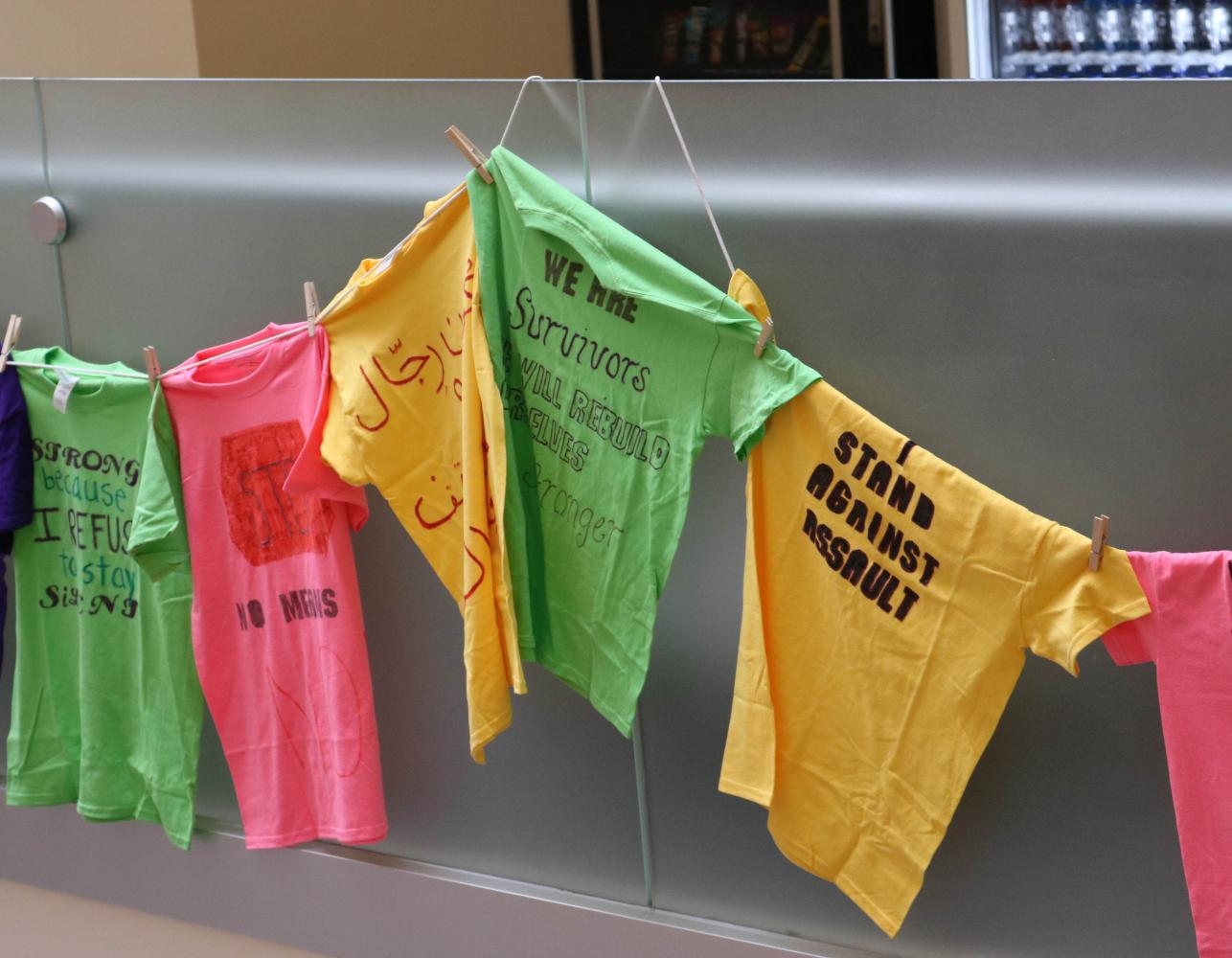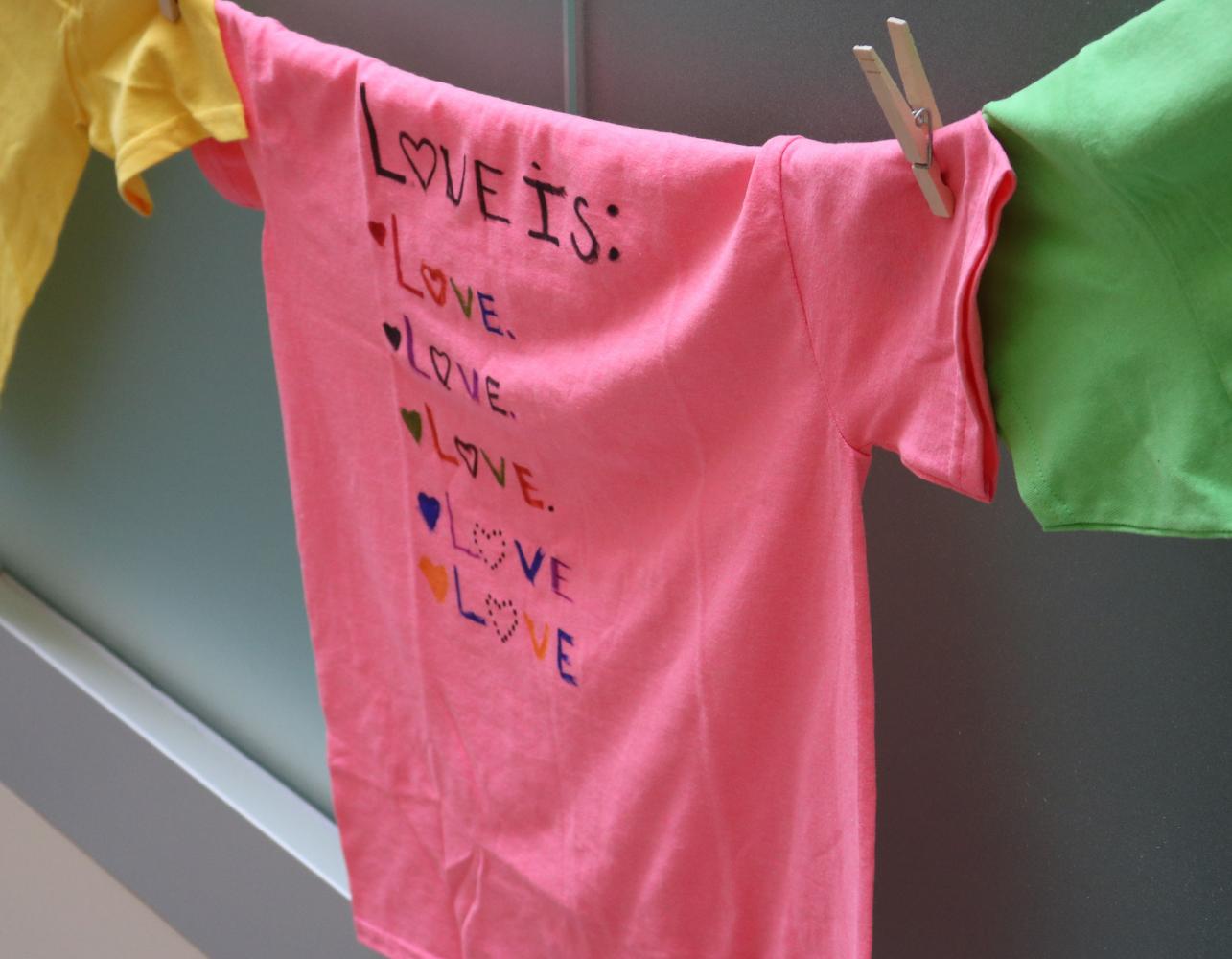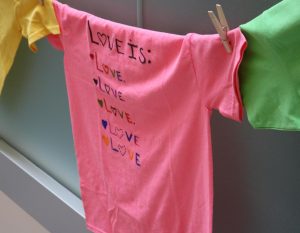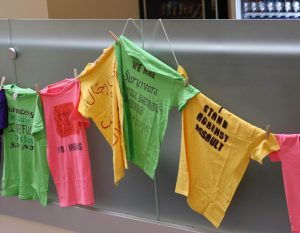Clothesline Project brings awareness
Oct 16, 2017
Starting on Monday, Oct. 9, UNI’s Women and Gender Studies (WGS) Program hosted T-shirt decorating to raise awareness of violence against women.
The project, which ended this past Friday, coincided with Relationship Violence Awareness Month. Students could write messages on T-shirts between 12 p.m. and 2 p.m. every day last week.
People who have been affected by violence, first-hand or otherwise, were invited to decorate a T-shirt with their thoughts, feelings and supportive messages surrounding the subject.
The messages remained anonymous, but the T-shirts were hung up on a clothesline for all to see.
“It’s neat to see other people…stopping to look at the T-shirts and for a second taking just a moment out of their own time to think about something that happened to someone else, that if they can’t relate to, can sympathize with and maybe change something that they do to help this issue,” said Anna Blaho, a third semester women and gender studies graduate student. Blaho is also the WGS Programming Graduate Assistant.
“It’s great if you come and support the event, but this is an event that is more for the survivors, so they know they’re not alone in witnessing and bearing what has happened to them,” Blaho said.
Color representation
“Our T-shirts all have different meanings and each color represents a different form of violence,” Blaho said. “We want to do our best to raise awareness for not only the kind of violence that we see more typically, but also the stuff that people don’t necessarily see. We want to provide a way for people who have been hurt by instances of violence, to come forth and share their story if they want to, to be able to heal and to send messages to other people.”
The white T-shirts represented women who have died due to violence, while yellow or beige represent battered or assaulted women.
Red, pink or orange represented survivors of rape and sexual assault. Blue and green T-shirts represent survivors of incest and sexual abuse.
Purple or lavender represent women attacked because of their sexual orientation and lastly, black is for women attacked for political reasons.
History
The Clothesline Project is a movement that started in Cape Cod, Massachusetts in 1990, as a way for women to tell their personal stories of relationship violence and to share positive messages with survivors. The movement also aimed to demonstrate the absence of those who had been lost to violence.
“Some women gathered and figured out that 58,000 soldiers died in the Vietnam War, but around the same time, 51,000 women were killed by men who claimed to love them. So, they were very conscious about the fact that relationship violence was not only alive and well, but also was not being attended to, and people weren’t actually seeing it as a problem,” Blaho said. “The Clothesline Project was a way for them to raise awareness for the violence that had been going under the radar for so long.”
“I basically organized the event, but I also reached out to the Center for Violence Prevention (CVP) at UNI, to help me co-sponsor the event because they deal a lot with relationship violence,” Blaho said. “Also, their Mentors in Violence Prevention (MVP) Program is working on teaching kids about relationship violence at younger ages, so they can recognize it.”
Collaboration
CVP collaborates with WGS on issues of relationship violence because each program has something different to offer when it comes to raising awareness.
“CVP educates students, and we provide intervention strategies, leadership training and by-stander program training to college students,” said Tsering Kyi, third semester graduate student in WGS. Tsering is also an internship student at the UNI CVP. “However, we are more specific to helping high school students and the community become more aware of gender violence. That’s why we collaborate with Women’s Gender Studies on these issues.”
CVP also aims to raise awareness about relationship violence.
“We have a lot of teen dating violence on college campuses and many students are not aware of those warning signs that they might be in unhealthy relationships, which might build up to domestic violence afterwards,” Tsering said. “The whole model of CVP is trying to address violence before it happens.”
“It’s a really moving moment to see people come forward and share their stories on a t-shirt for everyone to see, even though the T-shirts are anonymous when they’re hung up,” Blaho said. “Once you see all the T-shirts hung up and see all the messages people wrote, that’s probably the most powerful part.”
Krenare Loxhaj is a graduate student at UNI in women and gender studies, and she participated in the Clothesline Project.
“I am here to support the program and to support the initiative, because I think it is a great initiative,” Loxhaj said. “This is a good way of raising awareness amongst others who don’t necessarily experience these issues.”
According to the Rape, Abuse and Incest National Network website, women ages 18-24 are at an elevated risk of sexual violence and 11.2 percent of all students experience rape or sexual assault through physical force, violence or incapacitation. Also, 4.2 percent of students have experienced stalking since entering college.
“The reason it is important to have the Clothesline Project on a college campus is because rape and sexual assault is obviously still a very big issue that college campuses face,” Blaho said. “It’s not necessarily domestic violence on a campus, however, it certainly is relationship violence, and a lot of the same power dynamics are in the works.”











